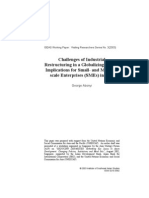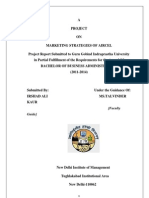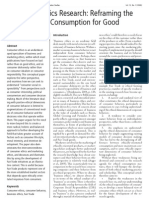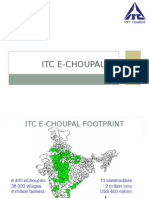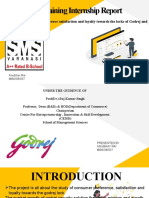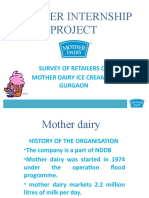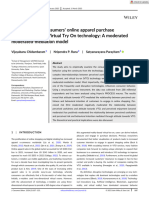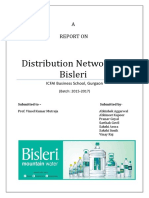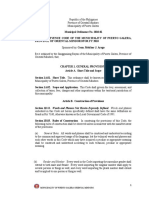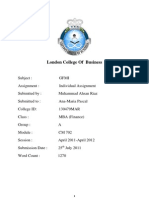TQM in Textile Industry
TQM in Textile Industry
Uploaded by
suleman090Copyright:
Available Formats
TQM in Textile Industry
TQM in Textile Industry
Uploaded by
suleman090Original Description:
Original Title
Copyright
Available Formats
Share this document
Did you find this document useful?
Is this content inappropriate?
Copyright:
Available Formats
TQM in Textile Industry
TQM in Textile Industry
Uploaded by
suleman090Copyright:
Available Formats
The Textile Institute 0135 87 JOTI 2005 Vol. 96 No. 2 pp.
8792
Corresponding Author:
Dr Neil Towers
Textiles and Paper Group
School of Materials, University of Manchester
M60 1QD, UK
Tel: +44 0161 306 3172 Fax: +44 0161 955 8391
Email: n.towers@manchester.ac.uk
INTRODUCTION
During the early days of manufacturing, an operatives
work was inspected and a decision made whether to accept
or reject it. As businesses became larger, so did this role,
and full-time inspection jobs were created. Accompanying
the creation of the inspection function caused other
problems to arise. These included:
More technical problems occurred requiring more
specialised skills
The inspectors themselves lacked training
Inspectors were ordered to accept defective goods, in
order to maintain factory throughput
Skilled workers were promoted into other roles, leaving
less skilled workers to perform the operational jobs
However, systems for improving and managing quality
have evolved rapidly in the last two decades. Simple
inspection activities have been replaced or supplemented
by the use of quantitative methods involving the application
of statistical techniques for quality control. With these
developments in assessing quality came new issues such
as setting of common standards, staff training, recording
of data and the accuracy and consistency of measuring
equipment. It had become clear that the scope for quality
was more than just product acceptance, and a need to
address defect prevention emerged. In the process of
progression, four discrete stages were identified, shown
in Fig. 1. These four levels include Inspection, Quality
Control, Quality Assurance and Total Quality Management.
There are two quite different approaches to quality
management in the workplace. Inspection and quality
control are a reactive approach based on the detection of
non-conforming product within a batch or sample.
However, quality assurance and total quality management
focus on a proactive approach of prevention by addressing
process as well as product performance. The performance
of the management infrastructure contributes to the
outcome of product quality rather than solely the technical
capability of the operation. Progression through the
different levels is supported by an organisation empowering
and caring for its staff and seeking continuous
improvement. It is driven by a positive approach to quality
management by learning from its shortcomings and
introducing sustainable improvements for the longer term.
TOTAL QUALITY MANAGEMENT
The model proposed by Dale (2003) identified a number
of basic principles that underpin a total quality management
approach to improving performance. These include
Effective Total Quality Management in the
textile fashion retail supply chain: A pilot
survey of the UK textile manufacturers
N. Towers
1
and J. McLoughlin
2
1
Textiles and Paper Group, School of Materials, University of Manchester, Manchester M60 1QD, UK
2
William Lee Innovation Centre, University of Manchester, PO Box 88, Manchester, M60 1QD, UK
Abstract: Total Quality Management (TQM) is a well documented philosophy for improving business
and operations activities through adopting quality management systems, procedures and competencies.
The approach is underpinned by the notion of striving for excellence in performance in fulfilling
customer expectations. The aim of this pilot survey is to examine how widespread TQM has been
implemented within the UK textile manufacturing sector that is characterised by a high proportion
of Small and Medium sized Enterprises (SMEs) managing unpredictable and volatile demand. The
survey investigates the effects of quality management systems on business performance and highlights
a number of difficulties including cost constraints, and lack of training and productivity improvements.
Reported benefits in team working, quality awareness and customer satisfaction were noted.
Key words: Textile supply chain, Total Quality Management, survey, SMEs.
doi:10.1533/joti.2004.0058
N. Towers and J. McLoughlin
JOTI 2005 Vol. 96 No. 2 88 doi:10.1533/joti.2004.0058 The Textile Institute
commitment and leadership, customer orientation, process
orientation and continuous improvement.
Total Quality Management (TQM) is an approach to
improving the competitiveness and flexibility of an
organisation for the benefit of all stakeholders. It is a way
of planning, organising and understanding each activity
and of removing all the wasted effort and energy that is
routinely exerted in the organisation. It ensures the leaders
within the organisation adopt a strategic overview of quality
and focus on the prevention of problems. The customer
orientation provides a common goal for all organisational
activities and for all the organisations members, and
incorporates both quality of the processes used in the
operation as well as conformance to the product
specification (Oakland, 2000). Each process in the chain
has a customer who demands total fulfilment of their
expectations and strives for excellence in performance.
The activities performed within an organisation can be
broken down into basic tasks or processes, normally seen
as the transformation of inputs into outputs by the
operation. Processes are linked in a series of interconnected
operations to form extended processes. In this way, TQM
attempts to emphasise that all employees are ultimately
involved in servicing the final customer. Satisfying
customers involves an incremental and continuous
improvement in performance through servicing their
requirements. It involves innovation and improvement
through small steps, often based on team working that
can lead to larger and more radical breakthroughs.
Measurement systems must be in place to monitor the
cost of quality and customer satisfaction. The more
intangible process metrics of TQM are supplementary to
the more traditional product measurement of defects and
variation. Figure 2 describes the range of participants
and processes involved in the quality management
system.
Monitoring the quality performance level of participants,
both internal and external to the business, towards their
customers requires a recording and evaluation activity
embedded in the operation. These assessments establish
the extent by which the customers needs and expectations
have been met. Process effectiveness and efficiency can
Continuous
improvement
Empowering people
Caring for people
Involvement
Compliance to
specification
Allocating blame
Inspection
TQM
QA
QC
QA
TQM
Total Quality
Management
(TQM)
Quality
Assurance
(QA)
Quality
Control
(QC)
Inspection
Policy deployment
Involve suppliers and customers
Involve all operations
Process management
Performance measurement
Teamwork
Employee involvement
Quality systems development
Advanced quality planning
Use of quality costs
FMEA
SPC
Develop quality manual
Process performance data
Self-Inspection
Product testing
Basic quality planning
Use of basic statistics
Paperwork controls
Salvage
Sorting grading, reblending
Corrective actions
Identify sources of non-conformance
Figure 1 The four levels in the evolution of TQM (Dale, 2003).
Continual improvement of the Quality Management System
Requirements
Customers
(and other
interested
parties)
Input
Management
responsibility
Resource
management
Measurement
analysis and
improvement
Product
realization
Product
Output
Satisfaction
Customers
(and other
interested
parties)
Figure 2 The process-based Quality Management System (BSI, 2000).
Effective Total Quality Management in the textile fashion retail supply chain
The Textile Institute doi:10.1533/joti.2004.0058 89 JOTI 2005 Vol. 96 No. 2
be assessed through internal and external audit and
incorporated into the control mechanisms.
QUALITY MANAGEMENT SYSTEM
As part of a TQM approach, an organisation must develop
and implement an appropriate quality assurance system
that is tailored to the type of manufacturing activity for
the product or service being offered. A fully documented
Quality Management System (QMS) will ensure that the
two important requirements of customer expectation and
the organisations requirements, both internally and
externally, are met.
The QMS is the means by which an organisation is
managed and controlled. The system should use processes
to achieve that outcome and are a balance between
procedures and staff competencies. There is a requirement
to identify the processes, determine their interaction, and
ensure that there is sufficient information to monitor
performance and maintain control within prescribed limits.
Processes are what needs to be done, who within the
organisation needs to undertake the task and what is the
intended result. Procedures and competencies will support
those processes and define how the activity is required to
be completed. Central to the philosophy is the assumption
that people, processes and performance are inextricably
linked (Porter and Tanner, 1996).
To achieve quality performance and to strive for
excellence, the notion of Total Quality Management has
been developed to incorporate the external dimension.
The processes are managed and continually reviewed to
fully satisfy the customers and to support the businesss
policy and strategy. Figure 3 illustrates the progression
of different stages in the pathway to excellence for an
organisation.
Takashima, 1992). Small and medium sized enterprises
(SMEs) with less than 250 employees accounted for nearly
44% of all employment in the UK (Day, 2000) but are
characterized by a different set of attributes that challenge
the adoption of a TQM approach. Their existence is
continuously exposed to risks of limited investment
capability and there is a difficulty of diverting skilled
personnel from day-to-day activities. There is also a
difficulty to undertake process re-engineering initiatives,
together with a lack of advanced planning support tools
specifically conceived for them (Mezgar et al., 2000). These
concerns provide for a different context in which TQM is
considered as a beneficial business strategic initiative. In
a comparative study, Dale and Duncalf (1984) studied the
quality management practices in a sample of 110 small
UK manufacturing companies and noted shortcomings
in their use of the quality assurance approach. It has been
estimated that about one third of all effort expended in
organisations is wasted time such as correcting errors,
searching for misplaced items, checking why products
are late, and redoing.
THE TEXTILE SECTOR
Many textile businesses have significantly reduced their
manufacturing capacity in the UK and have transferred
some or all of it overseas to Eastern Europe, the African
continent and Asia. With their significantly lower labour
and production costs, such companies are able to widen
their profit margins considerably. There remains a
significant textile manufacturing base in the UK, but as a
result of economic pressures, the textile sector is currently
predominantly populated with SMEs. By focussing their
operations on quality and speed of response as well as
cost, UK based organisations have been able to sustain a
position in their markets.
However, studies of SMEs within the sector have
identified gaps in TQM performance. Allen and Oakland
(1988) found that in a sample of 183 textile businesses the
small companies were not practising quality assurance as
well as their larger counterparts. In a later study (Allen
and Oakland, 1991) they commented that there was a
distinct lack of good management practices found in the
sample of companies studied from the British textile
industry. Although TQM is not a new concept, it is only
in the last few years that it has started to be implemented
in the clothing and textile industry in the UK (McLoughlin,
1999). Taylor (1994) suggested that utilising a formal quality
assurance system (ISO 9000) in textile manufacturing has
been accompanied by at least a perception that financial
savings have accrued.
TQM IN TEXTILES BUSINESSES
The number of textile organisations taking up quality
management systems within the UK has grown continually,
from a handful of organisations eight years ago to several
Excellence
TQM
Quality Assurance
Quality Control
Inspection
Figure 3 The way to excellence.
SMALL MANUFACTURING BUSINESSES
Changes in the UK manufacturing sector over recent times
have been well documented, with the predominant theme
of the downsizing of large companies and the growth of
small businesses (Hirst and Zeitlin, 1989; Thoburn and
N. Towers and J. McLoughlin
JOTI 2005 Vol. 96 No. 2 90 doi:10.1533/joti.2004.0058 The Textile Institute
hundred today. But the image of the clothing industry
with poor working conditions and authoritarian
management is unfortunately still often justified. However,
manufacturing units have become more modern and
streamlined, replacing some of the old clothing textile
mills with more contemporary ground-floor units and
the introduction of new technology has transformed some
of the production equipment. Many of the old practices,
such as the piecework payment system and crisis
management still remain.
With more and more textile organisations moving their
production offshore, it has been vital for the remaining
UK-based textile manufacturing businesses to retain a
strong position in their market. The need to engineer
high-quality supply chains to match customer requirements
has particular significance for textile products. Recognition
has been made of high product variety, innovative design
and responsive participants in agile textile supply chains
that combine with volatile and unpredictable demand
patterns (Childerhouse and Towill, 2000). Service level
performance is seen to be the order-winning characteristic
for agile supply (Mason-Jones et al., 2000). The two factors
of cost and customer service performance are essential to
the success and survival of the organisation. Customer
service considerations are paramount since, for all textile
manufacturing businesses the customer experience is the
prime differentiator to securing orders. Quality
management systems within a TQM approach share the
same requirements for an uncompromising commitment
to promoting excellence.
RESEARCH METHODOLOGY
The focus of the research was to investigate the impact of
total quality management in SMEs working in the textile
sector in the UK. The intention of this paper was to
undertake a pilot study to explore the validity of the
constructs developed by Dale (2003) and the
appropriateness of the generic process-based quality
management system developed by BSI (2000) to textile
manufacturing SMEs.
This research sought to achieve a number of objectives,
which were:
To examine how widespread TQM has been
implemented within small and medium sized textile
manufacturing enterprises in the UK.
To investigate the perceived effects of quality
management systems on SME business performance.
To propose further investigation for TQM with SMEs
in the textile fashion retail supply chain.
Research methods
A questionnaire was developed to explore the use of a
TQM approach within the organisation, specifically asking
questions about attitude and behaviour towards customer
orientation and the notion of excellence within the business.
The questionnaire was sent to 100 textile manufacturing
SMEs and was personally, addressed to the Owner/
Managing Director of the SME. From the responses, a
sample (n = 26) of SME textile manufacturers (that
included clothing manufacture, textile fabric manufacture
and textile finishing) returned completed questionnaires
for the research.
ANALYSIS OF RESULTS
The 26 responses to the questionnaire in the pilot survey
included 10 (38%) medium-sized businesses and 16 (62%)
small businesses. Of the respondents, 21 (81%) described
their current position as either board or senior management
whilst the remaining 5 (19%) described themselves as
middle management or a partner of their business.
The survey identified that 14 out of the 26 respondents
had introduced a quality management system, whilst two
companies had plans to do so within a year. This represents
over half (54%) of the surveyed enterprises reporting that
they had adopted formal quality management systems as
an integral part of the operating procedures within the
business (Table 1).
Table 1 Implementation of a Quality Management System
(QMS)
All Small Medium
organisations enterprises enterprises
QMS present 14 6 8
Planned QMS 2 2 0
No QMS 10 8 2
Of the 14 enterprises that reported adopting a QMS, 6
small businesses and 6 medium-sized businesses had
introduced formal quality management procedures within
the last 5 years whilst the remaining 2 medium-sized
businesses had introduced formal quality management
procedures more than 5 years ago (Table 2). Generally,
the adoption of quality management systems was a recent
phenomenon for the textile manufacturers.
Table 2 Adoption of a Quality Management System (QMS)
QMS present: All Small Medium
organisations enterprises enterprises
15 years 12 6 6
More than 5 years 2 0 2
From the financial perspective, the adoption of the
quality management system would be beneficial if it
contributed to an improvement in the profitability from
the investment in the operating processes of the SME.
Eight of the 14 respondents (57%) reported an
improvement in profitability as a result of incorporating a
QMS into the operating procedures of the SME (Table
3).
Effective Total Quality Management in the textile fashion retail supply chain
The Textile Institute doi:10.1533/joti.2004.0058 91 JOTI 2005 Vol. 96 No. 2
The majority of all respondents in the pilot survey
used failure/reject rate as the main quality performance
measure. Enterprises that have implemented a QMS tend
to have a broader range of quality measures. None of the
enterprises that had not adopted a QMS measured the
cost of quality and only 3 SMEs measured the number of
received customer complaints. A summary of the quality
performance measures is shown in Table 4.
The main reasons given by the respondents provide an
insight into the rationale and motivation behind the
adoption of a QMS for the textile manufacturing SMEs.
Customer requirements for supply and competitive
pressures are the two most common reasons (Table 5).
The most important difficulty associated with the quality
management system within the enterprises in the survey
was reported as cost constraints. There had been some
minor difficulties with an emphasis on short-term goals,
a lack of training and the quality improvement had
primarily been seen solely as a production concern
(Table 6).
The results from the respondents in the pilot survey
suggest that, in general, there is an overall perceived benefit
from developing a QMS as part of a total quality
management approach for an SME textile business. It
was found that the external environment in which textile
manufacturing SMEs operate predominantly requires the
adoption of TQM as a driver towards customer orientation
by the business. It had become a prerequisite requirement
for the textile SME to qualify for supplying product into
the marketplace.
EFFECTS FROM QMS IN STRIVING FOR
IMPROVEMENT
The questionnaire incorporated a number of questions
that were designed to explore the extent the respondents
were striving for improvement in different activities within
the businesses. The proposition was that focusing on
improving the business operation through the use of a
quality management system would promote the notion of
striving for excellence. The responses from the 14 SMEs
gave a greater understanding of the effects experienced
from the TQM approach to their operation. These
perceived views from the 14 respondents relating to
performance of their textile businesses are summarised in
Table 7. This indicates that the majority of the
manufacturing textile SMEs had experienced some degree
of improvement from the adoption of a TQM approach.
Half of the enterprises had reported major improvements
with quality awareness, team working, safety, scrap/defect
level reduction, customer satisfaction and additional sales.
The adoption of TQM in striving for excellence had
produced a limited effect on employee-related issues as
only minor improvements had been reported in labour
turnover and productivity. In fact the last attribute had
been the widest range of responses with no major
improvement or even deterioration being reported. Eight
of the 14 textile SMEs that had adopted a QMS reported
increased profitability. This might be interpreted as a
consequence of the major improvements gained from
adopting the TQM approach to striving for excellence.
Table 3 Profitability performance resulting from a
TQM approach
All Small Medium
organisations enterprises enterprises
Improved profit 8 3 5
Reduced profit 6 3 3
Table 4 The main quality performance measure
No of Failure/Reject Customer Customer Cost of Other
SMEs rates complaints feedback quality
All respondents 26 18 10 8 8 2
Enterprises 14 11 7 3 8 0
with QMS
Enterprises 12 7 3 5 0 2
without QMS
Table 5 Reasons for adopting a Quality Management
System
Reasons for adopting QMS Responses
Customer requirements for supply 63%
Competitive pressure 50%
Shorter lead times 13%
To achieve world class status 13%
Table 6 Difficulties associated with the Quality
Management System
Difficulties Major Minor Not a
concern concern concern
Cost constraints 2 5 2
Focus on short- 0 2 7
term goals
Seen as production- 0 2 5
only concern
Lack of training 0 4 4
N. Towers and J. McLoughlin
JOTI 2005 Vol. 96 No. 2 92 doi:10.1533/joti.2004.0058 The Textile Institute
SUMMARY OF FINDINGS FROM THE PILOT SURVEY
For UK-based textile manufacturing SMEs, operating with
a quality management strategy appeared to take a
considerable amount of time, patience and learning. It
can also be a costly process, but it was generally seen as an
investment that would provide a long-term benefit to the
business. Nearly two thirds of the respondents had
developed or were planning to implement a TQM approach
to their businesses. The textile SMEs saw TQM as an
important contributor to sustaining a customer-facing
operation. Although this pilot study had not sought to
investigate a link between company performance and TQM,
it was observed that all the businesses had experienced
increased customer demands for responsiveness and service
performance in parallel with customer lead TQM
requirements as a condition of supply.
TQM was seen as a method of removing waste by
involving everyone in improving the way things are done.
Incorporating quality management systems into a businesss
operating procedures as part of adopting a TQM approach
was about changing attitudes and skills so that the processes
become one of prevention rather than detection. Even
with the limited resources available to the SMEs, priority
was given to improving productivity and reducing costs
in supporting supply requirements to customers. The
constructs developed by Dale (2003) and used in this
research were found to be useful in the context of this
pilot study.
The pilot survey has provided some further
understanding of the supply process used by textile SMEs
operating in a very dynamic and volatile marketplace with
considerable competition from overseas companies. The
contribution that TQM had made to improve the operation
of the business was seen as important and necessary.
FUTURE RESEARCH
The intention is to undertake a large-scale survey of textile
manufactures in the UK that develops this research to
gain a greater understanding with a larger sample of SMEs
and larger businesses. The marketplace in the UK for
textile manufacturers continues to change at a fast rate as
fashion characteristics of supply are extended to different
retail outlets. It is suggested that future research investigates
the impact of these changes on TQM and its application
to customer-service performance.
REFERENCES
ALLEN, N. and OAKLAND, J., (1988). Quality assurance in the
textile industry: part 1, International Journal of Quality &
Reliability Management, 5 (5), pp 2537.
ALLEN, N. and OAKLAND, J., (1991). Quality assurance in the
textile industry: part 2, International Journal of Quality &
Reliability Management, 8 (1), pp 2230.
BSI (2000). BS EN ISO 9000: 2000.
CHILDERHOUSE, P. and TOWILL, D., (2000). Engineering supply
chains to match customer requirements, Logistics
Information Management, 13 (5), pp 337345.
DALE, B., (2003). Managing Quality, 4
th
Ed, Blackwell
Publishing.
DALE, B. and DUNCALF, A., (1984). A study of quality assurance
in small businesses Proceedings of the Institute of
Mechanical Engineers, 198B (6), pp 1359.
DAY, J., (2000). The value and importance of the small firm to
the world economy, European Journal of Marketing, 34 (9/
10), pp 10331037.
HIRST, P. and ZEITLIN, J., (eds) (1989). Reversing Industrial
decline? Industrial Structure and Policy in Britain and her
competitors, Berg, Oxford.
MASON-JONES et al. (2000). Engineering the leagile supply
chain International Journal of Agile Management Systems,
Spring 2000.
MCLOUGHLIN, J., (1999). Implementation of a zero breakdown
strategy, World Clothing Manufacturer, 80 (1), pp 1215.
MEZGAR, I., et al. (2000). Co-operative production planning for
small- and medium-sized enterprises International Journal
of Production Economics, 64, pp 3748.
OAKLAND, J., (2000). Total quality management: text with cases,
2nd ed Butterworth-Heinemann, Oxford.
PORTER and TANNER, (1996). Assessing Business Excellence: a guide
to self-assessment, Butterworth-Heinemann, Oxford.
TAYLOR, W., (1994). Organizational differences in ISO 9000
implementation practices International Journal of Quality
& Reliability Management, 12 (7), pp 1027.
THOBURN, J. and TAKASHIMA, M., (1992). Industrial
Subcontracting in the UK and Japan, Avebury, Aldershot.
Table 7 Business performance within TQM orientated textile manufacturers
Attribute Major Minor No Minor Major
improvement improvement effect deterioration deterioration
Quality awareness 7 4 3 0 0
Team working 3 7 4 0 0
Labour turnover 0 2 12 0 0
Safety 4 3 7 0 0
Customer complaints 5 7 2 0 0
Scrap/defect level reduction 4 5 5 0 0
Customer satisfaction 4 5 5 0 0
Additional sales 4 7 3 0 0
Productivity 0 4 7 3 0
Improved profitability 4 4 0 4 2
You might also like
- A Complete Liquor Store Business Plan SampleDocument25 pagesA Complete Liquor Store Business Plan Sampleelegua650% (4)
- Wine Spectator Vol. 41 N 06 (31 August 2016)Document198 pagesWine Spectator Vol. 41 N 06 (31 August 2016)Eugen OdainiiNo ratings yet
- Marketing Plan - LifebuoyDocument19 pagesMarketing Plan - Lifebuoyjain2007gaurav100% (2)
- Bhasin - 2012 - Performance of Lean in Large OrganisationsDocument9 pagesBhasin - 2012 - Performance of Lean in Large OrganisationsDragan DragičevićNo ratings yet
- MediaKit Better+Homes+and+GardensDocument24 pagesMediaKit Better+Homes+and+GardenstktkheyNo ratings yet
- Clusters of SMEsDocument28 pagesClusters of SMEsBalbhadra SinhNo ratings yet
- Strategic Marketing Management-: The Competitive Advantage & Value CreationDocument29 pagesStrategic Marketing Management-: The Competitive Advantage & Value Creationnaveen jaffriNo ratings yet
- Facility Layou DesignDocument6 pagesFacility Layou Designravishankar89No ratings yet
- Analytic Network Process (ANP) Method: A Comprehensive Review of Applications, Advantages, and LimitationsDocument7 pagesAnalytic Network Process (ANP) Method: A Comprehensive Review of Applications, Advantages, and LimitationsHamed TaherdoostNo ratings yet
- Chap 5Document47 pagesChap 5Mirna Bachir Al KhatibNo ratings yet
- PPT2-Corporate Governance and Strategic Management IssuesDocument26 pagesPPT2-Corporate Governance and Strategic Management IssuesRizaldi MaulanaNo ratings yet
- Reaserch ProposalDocument13 pagesReaserch ProposalNassiba NBNo ratings yet
- Strategy and Competition COMM 401: Internal AnalysisDocument16 pagesStrategy and Competition COMM 401: Internal AnalysisShruti SankarNo ratings yet
- A Design of A DSS For SCRM (Thesis)Document98 pagesA Design of A DSS For SCRM (Thesis)ramiraliNo ratings yet
- Book 6 - DRMDocument47 pagesBook 6 - DRMsuman subediNo ratings yet
- Analytical Hierarchy Process (AHP) Module: Exploration Systems Engineering, Version 1.0Document19 pagesAnalytical Hierarchy Process (AHP) Module: Exploration Systems Engineering, Version 1.0lim_mgNo ratings yet
- Katalog Teknik Buku ImportDocument21 pagesKatalog Teknik Buku ImportMuhammad RidwanNo ratings yet
- Cost Evaluation of RTMDocument118 pagesCost Evaluation of RTMAnonymous VRspXsmNo ratings yet
- Humanitarian Logistics - A New Field of Research and ActionsDocument102 pagesHumanitarian Logistics - A New Field of Research and ActionsdgdangelodgNo ratings yet
- GIS Based Land Suitability Assessment For Tobacco Production Using AHP PDFDocument10 pagesGIS Based Land Suitability Assessment For Tobacco Production Using AHP PDFMABAFEI AbaloNo ratings yet
- Industrial clusters and regional innovation: an evaluation and implications for economic cohesion (Eng)/ Clusters industriales e innovación regional (Ing)/ Industri klusterrak eta eskualdeko berrikuntza (Ing)Document18 pagesIndustrial clusters and regional innovation: an evaluation and implications for economic cohesion (Eng)/ Clusters industriales e innovación regional (Ing)/ Industri klusterrak eta eskualdeko berrikuntza (Ing)EKAI CenterNo ratings yet
- Site SPDocument13 pagesSite SPVener Arabit VitugNo ratings yet
- Basic Concepts PDFDocument36 pagesBasic Concepts PDFdyahNo ratings yet
- Applications of Operations Research in Supply Chain ManagementDocument8 pagesApplications of Operations Research in Supply Chain ManagementInternational Journal of Innovative Science and Research TechnologyNo ratings yet
- Clusters and Clustering PolicyDocument195 pagesClusters and Clustering PolicyDoroty CastroNo ratings yet
- Challenges of Industrial Restructuring in A Globalizing World: Implications For Small-And Medium - Scale Enterprises (Smes) in AsiaDocument50 pagesChallenges of Industrial Restructuring in A Globalizing World: Implications For Small-And Medium - Scale Enterprises (Smes) in Asiaa2b159802No ratings yet
- Internal Scanning: Organizational AnalysisDocument24 pagesInternal Scanning: Organizational AnalysispaceNo ratings yet
- ITC Chaupal Bazaar Tata Kisan Sansaar Hariyali Kisan Bazaar Godrej Aadhaar 3A BazaarDocument34 pagesITC Chaupal Bazaar Tata Kisan Sansaar Hariyali Kisan Bazaar Godrej Aadhaar 3A BazaarAshutosh SinghNo ratings yet
- Location, Competition, and Economic Development Local Clusters in A Global EconomyDocument20 pagesLocation, Competition, and Economic Development Local Clusters in A Global EconomyLuis Alberto Nemojón PuentesNo ratings yet
- Chapter 4 - Environmental Scanning & Industry AnalysisDocument38 pagesChapter 4 - Environmental Scanning & Industry AnalysisMohammod TahmidNo ratings yet
- Integrated Models of Location and RoutingDocument288 pagesIntegrated Models of Location and RoutingPawan JudgeNo ratings yet
- Internal ScanningDocument10 pagesInternal Scanninghamza100% (1)
- A HandyGuide To Emergency StandardsDocument41 pagesA HandyGuide To Emergency StandardsRoxana LopezNo ratings yet
- SCM AssignmentDocument2 pagesSCM AssignmentKING ME Gaming channel100% (1)
- Startup Internal Management AccountingDocument8 pagesStartup Internal Management AccountingRoki HassanNo ratings yet
- Green Supply-Chain Management.a State-Ofthe-Art Literaturereview.2007.Srivastava.Document28 pagesGreen Supply-Chain Management.a State-Ofthe-Art Literaturereview.2007.Srivastava.sankofakanianNo ratings yet
- History of Push and Pull Inventory PhillosophiesDocument6 pagesHistory of Push and Pull Inventory PhillosophiesRishaana SaranganNo ratings yet
- Lesson 5 Organizational Analysis and Competitive Advantage PDFDocument47 pagesLesson 5 Organizational Analysis and Competitive Advantage PDFLadybellereyann A TeguihanonNo ratings yet
- Transport ModelDocument3 pagesTransport ModelBergasNo ratings yet
- Understanding Supply Chain RobustnessDocument6 pagesUnderstanding Supply Chain RobustnessGuilherme VieiraNo ratings yet
- 7060maa Contracting Management Tendering Remote DeliveryDocument31 pages7060maa Contracting Management Tendering Remote DeliverySaniaNo ratings yet
- Corporate Social Responsibility 2Document21 pagesCorporate Social Responsibility 2kumawat.payal076No ratings yet
- Rfid I S C: B & F: N Upply Hain Enefits UtureDocument19 pagesRfid I S C: B & F: N Upply Hain Enefits UtureDineshNo ratings yet
- Supply Chain DriversDocument29 pagesSupply Chain DriversAbhinaba Ghose100% (1)
- Evaluation of Manufacturing Strategy and Role of ITDocument9 pagesEvaluation of Manufacturing Strategy and Role of ITPavan R KulkarniNo ratings yet
- BRP - Supply Chain ModellingDocument15 pagesBRP - Supply Chain ModellingNikit Chaudhary100% (1)
- Final Facility LocationDocument73 pagesFinal Facility LocationMrinal SandbhorNo ratings yet
- ITC Food's Growth and Future Prospects PDFDocument21 pagesITC Food's Growth and Future Prospects PDFManasa Macharla100% (1)
- Vertical Integration A Preliminary InsightDocument4 pagesVertical Integration A Preliminary InsightInternational Journal of Innovative Science and Research TechnologyNo ratings yet
- Inventory Management TechniquesDocument10 pagesInventory Management TechniquesVincent LawNo ratings yet
- To Study Marketing Strategies of AircelDocument60 pagesTo Study Marketing Strategies of AircelManish Sharma100% (1)
- Smart Warehouse vs. Traditional Warehouse - Review: Dr. Ali KamaliDocument8 pagesSmart Warehouse vs. Traditional Warehouse - Review: Dr. Ali KamaliVasudev GuptaNo ratings yet
- OM Assessment Exam AnswersDocument13 pagesOM Assessment Exam AnswersStar Dimasaca BenturadoNo ratings yet
- SCM Network Design: Loney T BabyDocument10 pagesSCM Network Design: Loney T BabyAnnonymous963258No ratings yet
- Chopra Meindel Chapter 7Document1 pageChopra Meindel Chapter 7Rishabh TiwariNo ratings yet
- Capacity and Aggregate PlanningDocument47 pagesCapacity and Aggregate Planningvishal vadadoriya90% (10)
- Gujarat Technological University: 1. Learning Outcomes: Learning Outcome Component Learning OutcomeDocument3 pagesGujarat Technological University: 1. Learning Outcomes: Learning Outcome Component Learning OutcomeBudha Lal100% (1)
- Digital Technology Enablers and Their Implications For Supply Chain ManagementDocument16 pagesDigital Technology Enablers and Their Implications For Supply Chain Management7dk6495zjgNo ratings yet
- Business and Consumer EthicsDocument10 pagesBusiness and Consumer EthicsGary WongNo ratings yet
- HBT 2307 HSM 2116 Supply Chain Management PracticeDocument2 pagesHBT 2307 HSM 2116 Supply Chain Management Practicemwakoja said100% (1)
- E-Choupal by ItcDocument33 pagesE-Choupal by ItcSatya Sekhar100% (1)
- End To End Supply Chain Management A Complete Guide - 2021 EditionFrom EverandEnd To End Supply Chain Management A Complete Guide - 2021 EditionNo ratings yet
- Airtel Case Study Channel StrategyDocument2 pagesAirtel Case Study Channel StrategyTushar GuptaNo ratings yet
- CCD BookDocument81 pagesCCD BookRahil MapariNo ratings yet
- AmzDocument60 pagesAmzBar Bus100% (1)
- Kantar Worldpanel Asia Pulse 2021 Issue 4Document27 pagesKantar Worldpanel Asia Pulse 2021 Issue 4Thanh BuiNo ratings yet
- Anubhav Rai Internship ReportDocument27 pagesAnubhav Rai Internship ReportAnubhav RaiNo ratings yet
- 1creating A Strategy That Works PDFDocument11 pages1creating A Strategy That Works PDFRedes Sociales SbuNo ratings yet
- Amul Kool-Sales & Distribution StrategyDocument16 pagesAmul Kool-Sales & Distribution Strategysamiksha agarwalNo ratings yet
- Flip KartDocument12 pagesFlip Kartpeehu100% (1)
- Chapter 1Document43 pagesChapter 1Jor SuarezNo ratings yet
- Summer Internship Project: Survey of Retailers of Mother Dairy Ice Creams in GurgaonDocument14 pagesSummer Internship Project: Survey of Retailers of Mother Dairy Ice Creams in GurgaonSushant SarkarNo ratings yet
- Enquiries: 1. Enquiry From A Retailer To A Foreign ManufacturerDocument11 pagesEnquiries: 1. Enquiry From A Retailer To A Foreign ManufacturerTrúc Ly Cáp thịNo ratings yet
- Online Footsteps To Purchase: Exploring Consumer Behaviors On Online Shopping SitesDocument11 pagesOnline Footsteps To Purchase: Exploring Consumer Behaviors On Online Shopping SitesdaryllNo ratings yet
- Marketing Research Project On Nike ShoesDocument8 pagesMarketing Research Project On Nike ShoesRi TalzNo ratings yet
- 506 B Retail ManagmentDocument11 pages506 B Retail ManagmentNilesh PatilNo ratings yet
- Virtual Try On TechnologyDocument19 pagesVirtual Try On Technologyzainab90zz00No ratings yet
- A REPORT On BisleriDocument24 pagesA REPORT On BisleriJITENDRA VISHWAKARMANo ratings yet
- Ashish Bhange - Changing Business Pratices and DigitizationDocument3 pagesAshish Bhange - Changing Business Pratices and DigitizationNikhil SakhardandayNo ratings yet
- Revised Revenue Code of Puerto Galera 2010Document157 pagesRevised Revenue Code of Puerto Galera 2010Jesselle MamintaNo ratings yet
- Gfmi PrintDocument6 pagesGfmi Printahsan1379No ratings yet
- Consumer BehaviorDocument19 pagesConsumer BehaviorPatricia Barlaan100% (2)
- The History of Ecommerce TimelineDocument3 pagesThe History of Ecommerce TimelineMoBaNo ratings yet
- Entrepreneur ProjectDocument13 pagesEntrepreneur Projecthiwot kebedeNo ratings yet
- BSL S2 2009 Pre-Seen InformationDocument24 pagesBSL S2 2009 Pre-Seen InformationShiqi TaoNo ratings yet
- ZChapter 2 Case Study On Walmart Retail Link SystemDocument7 pagesZChapter 2 Case Study On Walmart Retail Link SystemRohanNo ratings yet
- Sectoral StudiesDocument108 pagesSectoral StudiesIan Yoselle Narciso100% (1)
- ASDADocument4 pagesASDAhareem100% (1)


























